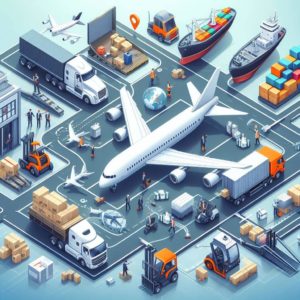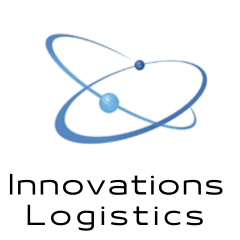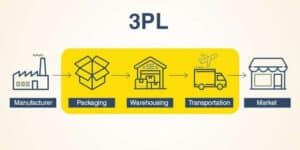[vc_row][vc_column offset=”vc_col-lg-9 vc_col-md-9″][vc_custom_heading source=”post_title” use_theme_fonts=”yes”][stm_post_details][vc_column_text css=”.vc_custom_1644315023601{margin-bottom: 30px !important;}”]Introduction:
The intermodal transportation system as we know it today emerged with the creation of steel containers in 1952 which is considered to be the fundamental evolutionary breakthrough in ocean freight. However, it ended up revolutionizing the traditional road transportation system, changing the game for the TSL sector and has greatly affected the global economy. Intermodal transportation is also referred to as combined transport as it uses a variety of transport modes mainly railroads.
When it comes to balancing the lowest price with efficient service the shippers prefer this widely expanding and reliable method which uses the rail network. Over the years we have witnessed constant investment in high-tech innovations for the processes involved in intermodal growth. To name a few game changers, automated gates for rail facilities, optical scanners, a network of smart tracks, electric cranes, etc. have ensured the safety and reliability of goods during the supply chain.
Considering all the contributions made in the mixed transport system, with the logistics companies continually switching over this vast network of intermodal transport; there comes an array of challenges that need to be addressed with operative solutions. Here we are discussing the major threats and challenges which are to affect the transport industry most.
Reliable Services
The greatest challenge for transport companies while offering intermodal freight transport is the provision of absolute reliable services. Though there have been made large investments in this sector, even then it won’t be wrong to say that this growing segment needs proper infrastructure which can compete with the growing nature of intermodal freight transport. Not being able to maintain the time schedule could be one of the greatest vulnerabilities for the transport companies. Some of the solutions to consider are ‘Smart tracks’ in rail infrastructure with detectors, optical scanners, and automated gates that can provide quick back and forth movement into rail facilities, enhancing the security as well as reducing mark time and providing an overall reliable service level.
Container Breaching
With a continuously expanding intermodal freight transport system, there comes another challenge related to port crime and container breaching. Container breaching and crime are often accompanied by internal conspiracies. Several modes of transportation are involved to keep mixed transportation working effectively, and this comes with taking care of additional threats coming at every stage. To overcome this challenge, direct human contact needs to be reduced, technologies like viable container security and ‘port automation’ should be considered to ensure the stability of processes and provide improved productivity and accuracy.
Integration of multiple organizations
Intermodal Transportation is complex, as it involves the movement of goods not through a single entity or organization. The whole system is based on the integration of both the public and private sectors. There are multiple handoffs, documents, and data elements that need to be taken care of on a large scale. Effective public and private sector collaboration are required to avoid the possible threats in this multi-organizational transportation system.
Transit Flexibility
The length of transits is an important factor that puts an effect on the managers who want to take advantage of intermodal transportation at its best. Time is taken in ramp delivery and railroad haul has limitations, once the train is moving, the containers are immobile and so leaving the shippers impossible to make alterations. Taking these factors into consideration it won’t be wrong to conclude that intermodal transportation is not as flexible as a traditional truckload. However, solutions for these can be proposed in order to overcome the flexibility gap for shippers and managers. Interlocked Emergency response and restart protocols need to be set in motion.
Drayage shortage and security
Drayage is an essential part of intermodal freight transportation across the globe. The trucks and the most important piece of drayage loading is the chassis. The rising stream of an overseas container has created a scarcity of drivers to get the chassis from port to drayage in-land areas. It’s fast becoming a challenge for the companies to secure enough safe land adjacent to ports and rail yards for all the necessary chassis activity to be performed including drop-and-picks of containers to more than one location. Though managing all the incoming traffic, controlling the shortage of drivers and chassis, tenanting the suitable land for drayage services is a challenge for drayage companies, it’s affecting the accelerating nature of intermodal freight transport. Hegemonizing of direct controls on overseas drayage services can lead to possible solutions for the drayage security and shortage issues.[/vc_column_text][stm_image_gallery images=”2896″][vc_column_text css=”.vc_custom_1644315092738{margin-bottom: 60px !important;}”]Summary:
To recapitulate, there are many domains in which intermodal transportation is continuing to be beneficial such as cost, high freight value, sustainability, and avoid congestions. However, this article investigates challenges that are yet to be worked out. As for the future of logistics, an increased level of cooperation between all the decision-makers and transport mode units remains the key point to the way forward. Intense collaboration of pubic and private sector focused on the research of the intermodal service network and consolidation strategies should be insight in the research leading to the improvement of intermodal transport operations.
Drayage operations are no doubt considered to be an exceedingly large contributor to the total costs of an intermodal transport system. The research on this sector remains limited. More research needs to be conducted on the topics like stuffing integrity, container breach detection, chassis fleet size in intermodal drayage operations, and overseas drayage security.[/vc_column_text][stm_post_bottom][stm_post_about_author][stm_post_comments][/vc_column][vc_column width=”1/4″ offset=”vc_hidden-sm vc_hidden-xs”][stm_sidebar sidebar=”272″][/vc_column][/vc_row]







